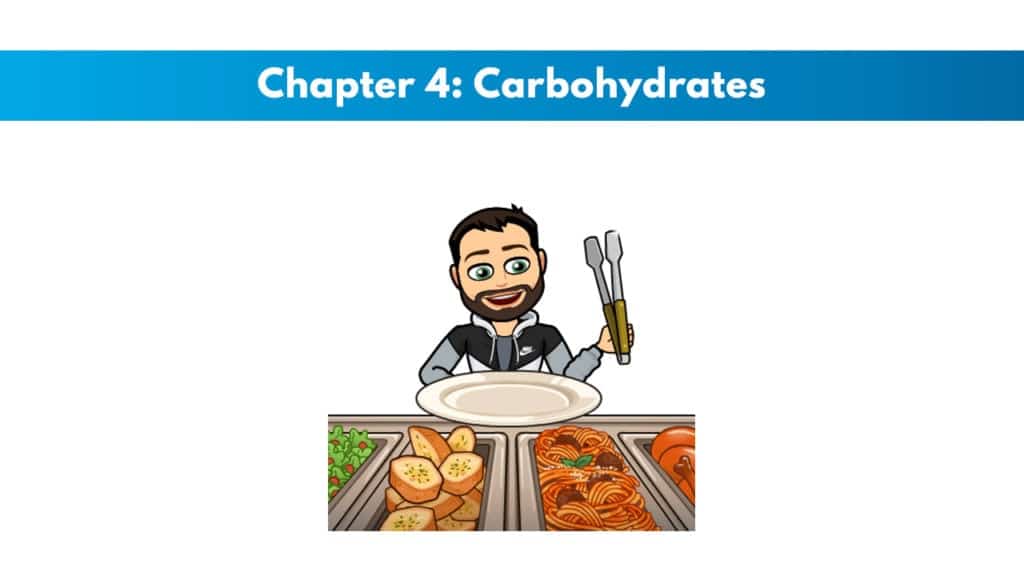
If you have not yet signed up for the ISSA Nutritionist certification, you can get it here for free as part of a special bundle.
Get your copy of the ISSA Nutritionist exam cheat sheet. It helps immensely for studying for the exam.
My PTP students report cutting their ISSA Nutritionist study time and effort in half with Trainer Academy.
Benefit from the Exam Pass Guarantee and Retake Fee Guarantee. Plus, take advantage of my current discount code PTPJULY for 50% off the MVP Program (Ends July 8th, 2025).
Try it out for free here to see if it’s right for you, or read my detailed review for further insights.
Chapter Goals:
- Find and be able to describe the different forms of carbohydrates.
- Be able to explain the importance of fiber in the diet.
- Be able to explain how glucose is stored and used for energy.
- Know how to describe how the human body digests carbohydrates.
Introduction
Carbs are a macronutrient that can be quite confusing for the general public.
We have many types of carbs, and they are classified based on their digestion process, and they provide a large energy source for the human body.
We must balance this nutrient well with the other macronutrients.
Carbohydrates
These are organic molecules that we use primarily for energy.
They are actually considered to be the main source of energy for the human body.
The role of carbs is to protect the body from using proteins and catabolizing its own muscle cells to provide energy for activity.
Glucose is a simple sugar comprising 6 carbons, 12 hydrogens, and six oxygens. One glucose molecule produces around 30 molecules of ATP via glycolysis during cellular metabolism.
The different types of carbs are based on the number of sugar units and their chemical structure.
Simple Carbohydrates
We have two types of simple carbs: monosaccharides and disaccharides.
Monosaccharides
These are going to be carbs consisting of one sugar unit. These are the simplest form of sugar and will make up the more complex carbohydrate molecules. Some examples are glucose, galactose, mannose, and fructose.
Exclusive PTP CPT Offers |
||
|---|---|---|
Most Popular Cert | Best Online NCCA Cert | Best Study Materials |
Gold Standard Cert | A Good Option | Best CPT for you?  |
Disaccharides
These carbs are made up of two sugar units. An example is sucrose, which is a combination of one glucose and one fructose.
Sugar is used as a catch-all term for different types of simple carbs.
The main monosaccharides in foods are glucose ad fructose. Glucose is found in fruits, sweet corn, corn syrups, some roots, and also in honey.
Fructose can also be known as levulose or fruit sugar, and it is found as a free monosaccharide in fruits and other foods.
Both fructose and glucose may be common simple sugars, but they still function differently as energy sources.
Complex Carbohydrates
There are two main types of complex carbs: Oligosaccharides and polysaccharides.
Oligosaccharides
The complex carbs have 3 – 10 sub-units of sugar. Some examples are raffinose and stachyose.
Polysaccharides
These are the most complex carbohydrates, with ten or more monosaccharide sub-units linked together. Starch is a main dietary complex carb.
Fiber
This special type of complex carb is not digested or absorbed in the small intestine. Fiber is sometimes going to be referred to as roughage or non-starchy polysaccharides.
Some of the main examples of this molecule are cellulose, hemicellulose, pectin, fructans, beta-glucans, and various gums.
We have two main types of dietary fiber: soluble and insoluble.
Soluble fiber
This type of fiber dissolves in fluids in the stomach to form a thick gel-like substance. It can be broken down by bacteria in the large intestine and gives some calories, usually nearly two per gram. This type of fiber sometimes interferes with the absorption of dietary fat and cholesterol.
Insoluble fiber
Exclusive PTP CPT Offers |
||
|---|---|---|
Most Popular Cert | Best Online NCCA Cert | Best Study Materials |
Gold Standard Cert | A Good Option | Best CPT for you?  |
This type of fiber does not dissolve in water, passes through the GI tract relatively together, and is not an actual source of calories.
The Role of Glycogen in the Body
This is the main storage unit of glucose in the body used for energy. It is similar to the starch found in plants, consisting of chains of glucose units.
The human body is limited in its storage capacity for glycogen, and thus we need a constant supply of carbs throughout the day.
The body converts a portion of all ingested complex carbs into glycogen, replenishing the short supply.
The total supply of glycogen in the body is limited to around 1,800 – 2,600 calories.
The body is in a state of constant storing and releasing of glucose to and from glycogen.
Glycogen is stored in all cells in the body, but it is mostly found in liver and muscle cells. These areas serve as reservoirs for glucose. The brain alone may use 400 calories or so each day just from the liver’s glycogen store.
Each glycogen is stored in the liver with around 3 ounces of water. This means water is also removed from the body when glycogen is used.
Carbohydrate Digestion
Carbs will take differing amounts of time to break down, dependent on the type of carb. Thorough and complete chewing of food is the first step in digestion and is important to make the process faster and more efficient.
From Mouth to Stomach
Digestion starts in the mouth with the act of chewing, also called mastication. This breaks down the food mechanically by grinding it into smaller units.
Saliva is used to lubricate the bolus to help it travel down the esophagus.
Amylase is the enzyme that breaks down the bonds holding multiple sugar unit carbs.
Only 5% of starches are broken down in the mouth, most of which will continue in the stomach.
From Stomach to Small Intestine
When the chyme enters the small intestine, the pancreas releases pancreatic juice. The pancreatic amylase is included here, which helps break down the dextrins into shorter chains.
Lactase breaks lactose into galactose and glucose
Maltase breaks the bond between two units of maltose
Sucrase breaks sucrose into glucose and fructose
Absorption into the Bloodstream
Monosaccharides are transported to the liver by the portal vein. The liver is the first destination for fructose, galactose, and glucose.
Glycemic Index
This is a ranking of carbohydrate-based foods on a scale of 0 – 100 according to their effect on blood glucose levels. Foods with a high GI will be rapidly digested, absorbed, and metabolized, leading to large fluctuations in one’s blood sugar.
Consumption of low GI foods results in smaller and slower changes in blood sugar levels. This help to keep the levels of fullness for a longer period of time.
GI depends on a few factors:
- Type of sugar: glucose is valued at 100, sucrose at 65, and fructose at 19. So, there is a bit of variance.
- Starch structure: amylose and amylopectin make up starch foods. Amylose makes foods harder to digest, thus, a lower GI.
- Processing: processed foods generally have a higher GI value than whole foods.
- Preparation: the longer a food is cooked, the higher the GI.
- Ripeness: The complex carbs in fruit break down to simple carbs as the fruit ripens.
Glycemic Load
The GI of food estimates how a food raises blood sugar levels but does not give info regarding the portions or quantity. That’s where glycemic load comes into play.
The GL is calculated as such:
(GI value of the food X the number of carbs of the serving in grams) / 100
Food sources of Carbohydrates
Carbs are inexpensive and common in many diets.
These include grains, fruits, dairy, legumes, snack foods, and sweets, drinks, and vegetables.
Recommended Dietary Allowances for Carbohydrates
Carbs are essential, and most people need significant amounts for good health.
The acceptable macronutrient distribution range for daily carb intake in adults will be between 45 – 65% of the total calories for the day.
So, if someone is consuming a 2,000 calorie diet, around 900 – 1300 of these calories would need to come from carbohydrate intake.
When someone desires to lose weight, carb intake may drop as low as 25 – 40 percent.
The optimal range of fiber per day is 21 – 38 grams, but in the US, adults receive around 12 – 18 grams of fiber each day. A good thing to shoot for is 14 grams of fiber for every 1,000 calories taken in.
Consumption of lower levels of refined sugars is optimal, along with increasing our intake of fibers and also the inclusion of more whole grains and complex carbs.
Carbohydrates and Athletes
The amount of carbs someone needs depends on their daily energy output. A good baseline to shoot for is that around 40 percent of daily calories come from net carbohydrates.
We should time the ingestion of carbs to where it does not cause a rapid rise in blood glucose levels and lines up well to help with energy production and sparing of the body’s glycogen reserves.
An important thing to look out for in athletes is using protein as an energy source. We must limit this happening, as the body will break down the muscle cells to give itself energy, and in the long run, this will significantly hurt athletic performance.

 Have a question?
Have a question? 



Tyler Read
PTPioneer Editorial Integrity
All content published on PTPioneer is checked and reviewed extensively by our staff of experienced personal trainers, nutrition coaches, and other Fitness Experts. This is to make sure that the content you are reading is fact-checked for accuracy, contains up-to-date information, and is relevant. We only add trustworthy citations that you can find at the bottom of each article. You can read more about our editorial integrity here.